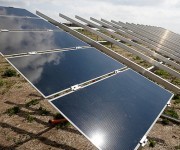Cross-posted from Climate Progress.
With solar module prices falling closer to the $1-a-watt threshold, many manufacturers are struggling to keep their heads above water. But project developers are doing quite swimmingly.
The continued decreases in panel prices are causing a boom in commercial-scale development throughout the U.S. According to analysis from Solarbuzz, the non-residential project pipeline has increased from 17,000 megawatts (MW) to 24,000 MW in just two months. Those figures include projects in all stages of development, so it doesn’t necessarily mean they’ll get built. But activity is increasing at an very rapid rate.
According to a 2010 analysis [PDF] from GTM Research and the Solar Energy Industries Association, the average total installed cost of solar systems in the U.S. fell 20 percent, due largely to the increasing size of projects and the reductions in module and hardware prices.
China continues its dominance in the global solar PV manufacturing sector. But the two leading suppliers to these non-residential projects are actually American companies — First Solar and SunPower. (However, those companies have moved much of their production to Asia.) The Chinese manufacturer Suntech is the third-largest supplier to these projects.
Even though many of the modules are being sourced from outside the country, these domestic installations provide an enormous value to local economies. According to a recent trade balance study from GTM Research, around 73 percent of the total economic value of a solar system stays in the U.S.
Despite the flurry of large-scale project activity in America, the country only represents 5 percent of the global market. But SolarBuzz expects total market activity to double this year, matching last year’s 102 percent growth, and possibly giving the U.S. a 12 percent share of the market by 2015.
That will depend on the stability of incentives, however. If the Treasury Grant Program is not extended, the industry will have to rely on a modest amount of tax equity to finance projects — possibly dropping the number of installations in 2013.


